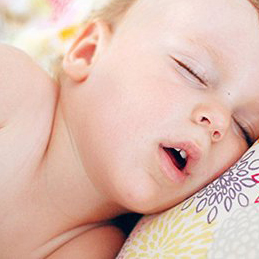Depth of palate and position of hyoid bone in mouth-breathing children
Keywords:
PALATINE BONE / MORPHOLOGY, HIOIDES / POSITION, CHILDREN, MOUTH BREATHING.Abstract
Introduction: respiratory needs are the main determinant of the posture of jaws, tongue and head; that is why an altered respiratory pattern produces morphological changes of the palate along with the position of the hyoid bone.
Objective: to determine the depth of the palate and position of the hyoid bone in mouth-breathing children from 9 to 11 years old.
Method: an analytical research of cases and controls was carried out. The target group was comprised of 107 patients and the sample included 60 patients (30 mouth-breathing children group, and 30 nasal-breathing children in the control group). Lateral cephalograms were taken from the skull. Linear and / or angular measurements were used to determine the position of the hyoid bone; a slide gauge and an acrylic template were used to measure the depth of palate.
Results: a mean palatine depth was obtained at the canines’ level of 5.28 mm and at the molar level of 14.00 mm in the mouth breathing group with 5.74 mm and 10.18 mm respectively in the control group. Negative measures with respect to the distances H-H’ and C3-Gn-H of the hyoid bone predominated. Significant differences were found between the two study groups at a significance level of 5%.
Conclusions: the mouth breathing group presented a palatal depth greater at the molar level and slightly lower at the canine level than the control group. The hyoid showed a postero-inferior position in the mouth-breathing group.
Downloads
References
1. Díaz Morell J, Pellitero Reyes B, Rodríguez Carracedo E, Ayala Pérez Y, Segura Martínez N, Carmona Vidal E. Maloclusiones, signos y síntomas de trastornos temporomandibulares en adolescentes de la Parroquia Jusepín. Monagas. Venezuela. Correo Científico Médico [Internet]. 2012 [citado 2016 Oct 31]; 16(4): [Aprox. 10 p.]. Disponible en: http://revcocmed.sld.cu/index.php/cocmed/article/view/315
2. Bravo F, Navarrete A, Niño A, Rodríguez E, Martín Ardila C, Guzmán CL. Evaluación tridimensional de la vía aérea mediante tomografía computarizada de haz de cono. AMC [Internet]. 2012 Jun [citado 2016 Oct 31]; 16(3): [Aprox. 16 p.]. Disponible en: http://scielo.sld.cu/scielo.php?script=sci_arttext&pid=S1025-02552012000300005&lng=es
3. Podadera ZR, Podadera FL, Díaz RA. Repercusión de la respiración bucal en el sistema estomatognático en niños de 9 a 12 años. Rev. Ciencias Médicas. [Internet]. 2013 [citado 2016 Oct 31]; 17(4): [Aprox. 11 p.]. Disponible en: http://scielo.sld.cu/pdf/rpr/v17n4/rpr14413.pdf
4. Aguilera Fernández J, Aguilera Bauzá S, Toledo Aguilera B, Morales Corella V, Sulimán Benítez M. Hábitos bucales deformantes y maloclusiones en pacientes de Ortodoncia. Correo Científico Médico [Internet]. 2013 [citado 2016 Oct 31]; 17(1): [Aprox. 12 p.]. Disponible en: http://revcocmed.sld.cu/index.php/cocmed/article/view/1243
5. Reynaldo González R, Bello Jerez J, Cejas Prieto D. Hábitos bucales deformantes en niños de tres a cinco años de edad de la Policlínica Mario Gutiérrez Ardaya. Correo Científico Médico [Internet]. 2013 [citado 2016 Oct 31]; 17(1): [Aprox. 14 p.]. Disponible en: http://revcocmed.sld.cu/index.php/cocmed/article/view/1242
6. Torres Molina A. Prevalencia de los trastornos respiratorios asociados al sueño en escolares. Medisur[Internet]. 2012 [citado 2016 Oct 31]; 10(2): [Aprox. 15 p.]. Disponible en: http://www.medisur.sld.cu/index.php/medisur/article/view/1725
7. Urbanová P, Hejna P, Zátopková L, Safr M. Asimetría y Modularidad del Hueso Hioides.Int. J. Morphol. [Internet]. 2014 [citado 2016 Oct 31]; 32(1): [Aprox. 18 p.]. Disponible en: http://www.scielo.cl/scielo.php?pid=S0717-95022014000100042&script=sci_arttext
8. Ocampo Fonseca I, Aguilar Saavedra CM, Sánchez Ramos MF. Cambios en la posición de las estructuras esqueléticas del complejo cráneo- cervical posterior a cirugía ortognática. Revista odontológica mexicana. [Internet]. 2013 [citado 2016 Oct 31]; 17(4): [Aprox. 27 p.]. Disponible en: http://www.sciencedirect.com/science/article/pii/S1870199X13720391
9. Giraldo Vélez N, Olarte Sossa M, Ossa Ramírez JE, Parra Isaza MA, Tobón Arango FE, Agudelo Suárez AA. Características de la oclusión en respiradores bucales de 6 a 12 años de la Clínica del Niño en la Facultad de Odontología de la Universidad de Antioquia. Rev Nac Odontol. 2015; 11(20): [Aprox. 14 p.]. Disponible en: http://revistas.ucc.edu.co/index.php/od/article/viewFile/759/890
10. Abril Ochoa DG. Evaluación de la posición hioidea en radiografías de pacientes clase I, II y III esqueletales entre 9 y 18 años de edad registrados en el período 2012 y 2015, de un centro radiológico de la Ciudad de Cuenca. [Tesis en Internet]. Ecuador: Universidad de Cuenca. Facultad de Odontología; © 2016 [citado 7 Nov 2016]. [Aprox. 56 p.]. Disponible en: http://dspace.ucuenca.edu.ec/bitstream/123456789/24661/1/TESIS.pdfç
11. Carulla D, Espinosa D, Mesa T. Estudio cefalométrico del hueso hioides en niños respiradores bucales de 11 años: Segunda Parte. Rev Cubana Estomatol [Internet]. 2010 [citado 2016 Oct 31]; 47(2): [Aprox. 20 p.]. Disponible en: http://scielo.sld.cu/scielo.php?script=sci_arttext&pid=S0034-75072008000200007

Published
How to Cite
Issue
Section
License
Authors who have publications with this journal agree to the following terms: Authors will retain their copyrights and grant the journal the right of first publication of their work, which will be publication of their work, which will be simultaneously subject to the Creative Commons Attribution License (CC-BY-NC 4.0) that allows third parties to share the work as long as its author and first publication in this journal are indicated.
Authors may adopt other non-exclusive license agreements for distribution of the published version of the work (e.g.: deposit it in an institutional telematic archive or publish it in a volume). Likewise, and according to the recommendations of the Medical Sciences Editorial (ECIMED), authors must declare in each article their contribution according to the CRediT taxonomy (contributor roles). This taxonomy includes 14 roles, which can be used to represent the tasks typically performed by contributors in scientific academic production. It should be consulted in monograph) whenever initial publication in this journal is indicated. Authors are allowed and encouraged to disseminate their work through the Internet (e.g., in institutional telematic archives or on their web page) before and during the submission process, which may produce interesting exchanges and increase citations of the published work. (See The effect of open access). https://casrai.org/credit/


